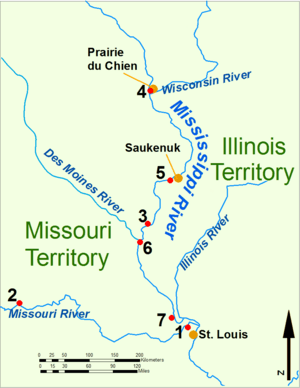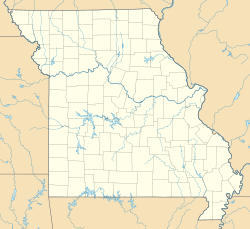Fort Osage facts for kids
|
Fort Osage
|
|

Fort Osage from the west. The "factory" trading post is on the left.
|
|
| Location | Sibley, Missouri |
|---|---|
| Built | 1808 |
| NRHP reference No. | 66000418 |
Quick facts for kids Significant dates |
|
| Added to NRHP | October 15, 1966 |
| Designated NHLD | November 5, 1961 |

Fort Osage was an important trading post and fort built by the United States Government in the early 1800s. It was located in what is now Sibley, Missouri, in the western part of the state. People also called it Fort Clark or Fort Sibley.
The fort was created after a special agreement, the Treaty of Fort Clark, was signed in 1808. This treaty was made with some members of the Osage Nation. The United States promised to build Fort Osage as a place for trade and to protect the Osage people from their enemies.
Fort Osage was one of three forts built by the U.S. Army. These forts helped the U.S. gain control over the new lands from the Louisiana Purchase. Fort Madison in Iowa helped control trade on the Upper Mississippi River. Fort Belle Fontaine near St. Louis watched over the mouth of the Missouri River.
Fort Osage stopped operating in the 1820s. By then, the Osage had given up more of their land in Missouri to the U.S. government. Today, a copy of the original fort stands on the same spot. It was built between 1948 and 1961. The local school district, including Fort Osage High School, is named after this historic fort.
Contents
Exploring the Missouri River
In June 1804, explorers Meriwether Lewis and William Clark were on their famous journey up the Missouri River. They were looking for a water route to the Pacific Ocean. During their trip, they camped near the spot where Fort Osage would later be built.
They noticed it was a "high commanding position," perfect for a fort. It stood over 70 feet above the river. Later that year, Pierre Chouteau, a fur trader and agent for the Osage, took Osage chiefs to meet President Thomas Jefferson.
President Jefferson promised to build a trading post for them. He believed that government trading posts would be better than private traders. He thought they would help build good relationships with Native American tribes.
Building the Fort
In September 1808, William Clark returned to the site to start building Fort Osage. Two months later, in November 1808, Pierre Chouteau helped create the Treaty of Fort Clark. This treaty allowed the fort to be built to protect the Osage Nation.
The treaty said that the United States wanted peace and friendship with the Osage. They wanted to help and protect them from other tribes. So, they agreed to build a fort on the Missouri River. This fort would have soldiers to protect friendly Osage people.
In return for this trading post and protection, the Osage agreed to give up their lands east of the fort to the U.S. This left them with a smaller area of land in western Missouri. The Great Osage received $1,000, and the Little Osage received $500 as part of the agreement. The government trading post opened in 1808 but moved to Arrow Rock in 1813.
Life at Fort Osage
Captain Eli Clemson officially named the fort "Fort Osage." He was in charge of the soldiers there from 1808 until 1813. People also sometimes called it "Fort Clark" after William Clark, who handled Native American affairs.
Fort Osage was one of the first U.S. military bases in the Louisiana Territory. It became a major stop for travelers on the Missouri River. Famous people like Daniel Boone visited in 1816 when he was 82 years old. Sacagawea, who helped Lewis and Clark, also stayed there with her husband, Toussaint Charbonneau.
The fort was left empty in June 1813 during the War of 1812. There wasn't much fighting in that area, so the soldiers were sent to other places. After the war ended, the fort was reopened in 1815. It became a very successful trading spot. The first manager, George C. Sibley, reported that trade with the Osage was good. He said goods were sold for "less than half what the traders extort from them."
Closing the Fort
After the War of 1812 and another agreement called the Adams–Onís Treaty, there was less danger from other countries. The Osage also gave up more of their land. Because of this, the U.S. built a new trading post at Fort Scott, Kansas. This new fort was closer to the Osage villages near the Osage River.
Fort Osage officially closed in 1822. However, it remained an important landmark on the Santa Fe Trail. It was also a place where supplies were moved north. By 1836, the fort was gone. Local settlers used its pre-cut wood to build their own homes and barns. The last building, the factory house, burned down, leaving only its rock foundation.
Fort Osage National Historic Landmark
In the 1940s, archaeologists found the old foundations of Fort Osage. The fort was rebuilt to look exactly as it did in 1812. This was possible because William Clark and others had made detailed maps and surveys.
The rebuilt fort is now called the Fort Osage National Historic Landmark. It is also listed on the National Register of Historic Places. Jackson County Parks and Recreation in Missouri owns and runs the site. You can visit it Tuesday through Sunday from 9:00 AM to 4:30 PM all year.
The Fort Osage Education Center opened in November 2007. It has exhibits about the area's geology and nature in the 1800s. You can learn about the ancient Hopewell people and the Osage culture. There are also exhibits about Lewis and Clark, Fort Osage, and the Missouri River. The site also has live demonstrations that show what military and civilian life was like in the early 19th century.
See also



